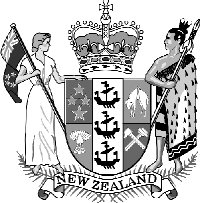Gavin's Home Page
The Treaty
Pre Treaty
> Pre-Treaty History of Aotearoa
> He
Wakaputanga O Te Rangatiratanga O Nu Tireni
> The
Declaration of Independence of New Zealand
The Treaty
> Te
Tiriti O Waitangi
> The
Treaty of Waitangi
> English
Translation of the Māori
Text
> Commentary on the Treaty
> Locations
of Treaty Signings
> The
1869 Māori Translation
Post Treaty
> Legislative Violations of the Treaty
>Crown Apology to Ngai Tahu
> E Whakaae ana te Karauna ki a Ngai Tahu
> Plastic
Tiki and other Nasty Things
Any corrections or comments are welcome. Contact me.
Last updated 6 February
2001.
Site
History

TREATY OF WAITANGI
A TRANSLATION OF THE MĀORI TEXT
Signed at Waitangi, February 1840, and afterwards by over 500 chiefs.
Victoria, the Queen of England, in her kind (gracious) thoughtfulness to the Chiefs and Hapū of New Zealand, and her desire to preserve to them their chieftainship and their land, and that peace and quietness may be kept with them, because a great number of the people of her tribe have settled in this country, and (more) will come, has thought it right to send a chief (an officer) as one who will make a statement to (negotiate with) Māori people of New Zealand. Let the Māori chiefs accept the governorship (Kawanatanga) of the Queen over all parts of this country and the Islands. Now, the Queen desires to arrange the governorship lest evils should come to the Māori people and the Europeans who are living here without law. Now, the Queen has been pleased to send me, William Hobson, a Captain in the Royal Navy to be Governor for all places of New Zealand which are now given up or which shall be given up to the Queen. And she says to the Chiefs of the Confederation of the Hapū of New Zealand and the other chiefs, these are the laws spoken of.
THIS IS THE FIRST
The Chiefs of the Confederation, and all these chiefs who have not joined in that Confederation give up to the Queen of England for ever all the Governorship (Kawanatanga) of their lands.
THIS IS THE SECOND
The Queen of England agrees and consents to the Chiefs, hapū, and all the people of New Zealand the full chieftainship (rangatiratanga) of their lands, their villages and all their possessions (taonga: everything that is held precious) but the Chiefs give to the Queen the purchasing of those pieces of land which the owner is willing to sell, subject to the arranging of payment which will be agreed to by them and the purchaser who will be appointed by the Queen for the purpose of buying for her.
THIS IS THE THIRD
This is the arrangement for the consent to the governorship of the Queen. The Queen will protect all the Māori people of New Zealand, and give them all the same rights as those of the people of England.
William Hobson, Consul and Lieutenant-Governor
Now, we the Chiefs of the Confederation of the Hapū of New Zealand, here assembled at Waitangi, and we, the chiefs of New Zealand, see the meaning of these words and accept them, and we agree to all of them. Here we put our names and our marks.
This was done at Waitangi on the 6th day of February in the year of our Lord 1840.
At a meeting before any of the Chiefs had signed the Treaty, Hobson agreed under questioning from the Catholic Bishop Pompallier to read the following statement which was a record of discussion on religious freedom and customary law, which the Bishop Pompallier had had with the Anglican Missionary William Colenso.
E mea ana te Kawana ko ngā wakapono katoa o Ingarani, o ngā Weteriana, o Roma, me te ritenga Māori hoki e tiakina ngātahitia e ia.
Translation:
The Governor says that the several faiths (beliefs) of England, of the Wesleyans, of Rome, and also Māori custom shall alike be protected by him.
This is sometimes referred to as the fourth article or protocol.
![]()
Māori Language Home Page | The Treaty | Te Tiriti | Commentary | Locations of Treaty Signings | The 1869 Māori Translation
This text supplied by Network Waitangi Ōtautahi. Trustbank Community House, 187 Cashel St, Ōtautahi (Christchurch). Ph (03) 365-5266; Fx (03) 366-8535.